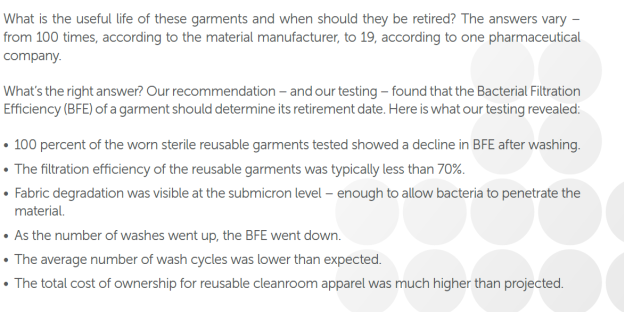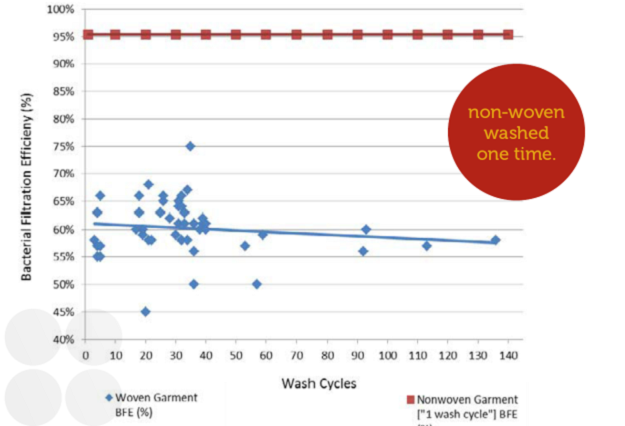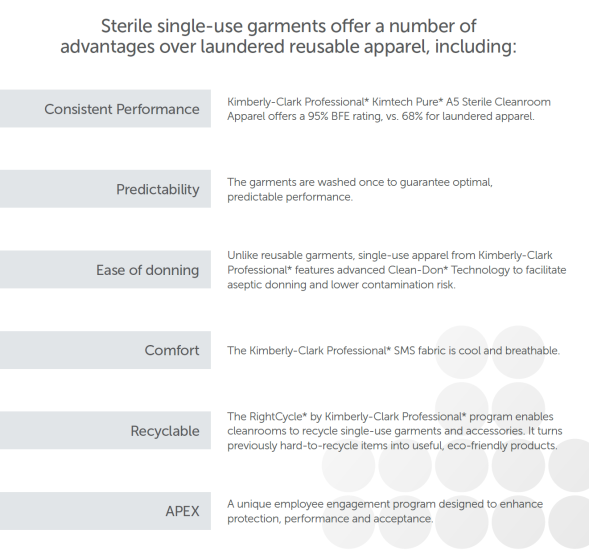Cleanroom Garment IIoW Decision Loops
TABLE OF CONTENTS
·
OVERVIEW
·
BACKGROUND
o
Reusable
o
Disposable
o
Combination
·
DISPUTED COST OF OWNERSHIP FACTORS
____________________________________________________________________________
OVERVIEW
McIlvaine is initiating a number of IIoW
Decision Loops to help cleanroom operators make
the lowest total cost of ownership (LTCO)
choices. The Industrial Internet of Wisdom (IIoW)
connects all the knowledge to provide validation
of the choice. This can be labeled Lowest Total
Cost of Ownership Validation (LTCOV).
Validation is defined as successful
communication of a superior choice. This
communication requires a loop connecting the
media, events, niche experts, associations,
purchasers, and suppliers. It requires accurate
classification and easy access to support
documents.
McIlvaine is supplying the proposed structure
and encouraging the industry to provide the
details. Part of the effort needs to be
identification and debate of disputable issues.
Cleanroom Garment IIoW Decision Loops
·
Reusable vs Disposable
·
Reusable
o
fabric selection
o
garment selection
o
processing selection
o
vendor selection
·
Disposable
o
fabric selection
o
garment selection
o
vendor selection

These decision loops need to be unique depending
on the industry, cleanroom class and process.
The criteria for cytotoxic drugs need to
prioritize worker protection. 2nm chip
production requires
conditions better than ISO 3. A hospital
operating room, Covid isolation room, and
compounding pharmacy all have different cost
factors.
BACKGROUND
Here is background information for the loops.
The Case for Reusable Garments
Prudential Makes the Case for Reusable Garments
Environmental Impacts
Most companies that use cleanroom products do
not consider the environmental impacts. It
entails more than just solid wastes being dumped
in a landfill. The materials used to make
disposables can be broken down into two basic
components: fabrics and contaminates. Fabrics
are inert and will biodegrade over time without
any impact to the environment. Contaminates, on
the other hand, are those materials that
biodegrade and, in the process, release CO2
(carbon dioxide) and CH4 (methane) from chemical
reactions. Reusable garments are made from
polyethylene terephthalate (PET), which is the
same plastic used to manufacturer plastic
drinking bottles. PET is fully recyclable and
able to be reused numerous times, with minimal
impacts to the environment.
Lifecycle Comparison
The lifecycle of reusable and disposable
garments includes several different factors,
such as the cost for the garments, the company’s
CO2 footprint, energy use, and solid waste.
Disposables go through the following stages
during their lifecycle:
·
Manufacturing
·
Cleanroom Use
·
End of Life
Reusables go through the following stages during
their lifecycle:
·
Manufacturing
·
Cleanroom Use
·
Laundry Transport
·
End of Life
With reusables, after each cleanroom use, they
are transported to a laundry facility where they
are washed and, if needed, sterilized, before
being returned to the company to be used again.
The cycle continues until the end of life of the
garment.
Twenty reusables are able to be reused 50 times
on average, compared to using 1,000 disposables.
The costs for purchasing the reusables and
paying a laundry service to wash them is much
less than the cost paid for the disposables. In
addition, the total amount of energy and
resources used over the entire lifecycle in
megajoules (MJ) for reusables is about 8,380 MJ,
compared to 10,900 to 19,200 for disposables,
depending upon the materials used to make the
disposables.
Businesses which choose a disposable cleanroom
garment solution incur the following (per
520,000 units):
·
30-129% increase in natural resource usage
·
52-143% increase in energy use (throughout
lifecycle)
·
38-135% increase in the business’s CO2 footprint
·
17 times more solid waste contribution in
landfills
·
4 times more water usage (throughout lifecycle)
Alternatively, using 10,400 units of reusables
helps save approximately 3.5 million MJ of
energy, with a 210,000 kg reduction in CO2
emissions. In the end, using reusables is better
for the environment, saves com
Source: Overcash, Michael, Eric Vozzola, and
Evan Griffing. “Implications of Reusable Versus
Disposable Garments – Environmental Dimensions
of Cleanroom Coveralls.” 8 October 2015. PDF
File.panies money, and reduces overall waste
The American Reusable Textile Association (ARTA)
Study
A study was
conducted on the environmental and economic
impacts of using reusable and disposable
cleanroom garments. The ARTA-supported study was
conducted by Environmental Clarity
and
based, in part, on a previous life cycle
analysis on cleanroom coveralls published in the
PDA Journal.
In cleanroom facilities, both disposable and
reusable textile garments meet the particulate
standards from most rigorous to the most basic
levels. However, the reusables offer two
additional benefits, lower cost and reduced
environmental impact. The environmental and
economic benefits when cleanrooms select
reusable textile garments are now clearly
defined in detail (based on estimates from
detailed life cycle data on reusable and
disposable products) and can be used by both
suppliers and customers to add to their own
environmental sustainability scorecards.
Environmental and economic savings
The study found that when US cleanroom
operations choose reusable coveralls over
disposable ones:
-
More than 141 million megajoules
(MJ) non-renewable energy (nre)
(38 million kWh) is saved each
year. Over a decade, 1.4 billion
MJ nre is saved.
-
Annually, this
environmental
savings is
equivalent to
offsetting the
carbon emissions
from 1,650 cars
annually,
substituting for
the diet impact
of 4,100
persons, or
displacing
89,000 iPads
(design life).
-
Annually, this
environmental
savings is
equivalent to
offsetting the
carbon emissions
from 1,650 cars
annually,
substituting for
the diet impact
of 4,100
persons, or
displacing
89,000 iPads
(design life).
-
Costs are reduced by 58% over
disposables and provide an
economic savings estimated at
$120 million each year, which is
$1.2 billion over a decade.
-
The financial
savings of a
full-market use
of reusables
would be about
$210
million/year
(nearly $2.1
billion in a
decade). In
order to capture
the full benefit
of reusables for
a future market,
87.5% reusables
was analysed
(12.5% are
mandatory
disposables).
-
The financial
savings of a
full-market use
of reusables
would be about
$210
million/year
(nearly $2.1
billion in a
decade). In
order to capture
the full benefit
of reusables for
a future market,
87.5% reusables
was analysed
(12.5% are
mandatory
disposables).
These new US data quantify and reinforce the
economic and environmental benefits of cleanroom
decisions for selecting reusables. This
information can be used by policy makers,
sustainability program directors, purchasing
organizations, and others.
From this study, the reusable cost savings did
not appear to depend on the size of the
cleanroom operation nor the region of the
country located. These benefits are directly
accrued to the cleanroom organizations in their
financial reporting and increasingly to their
sustainability scorecards. In addition, the
manufacturers and the laundry organizations can
share the sustainability credits with all their
customers. The study concludes that providing
this information can help cleanroom firms'
decision-making and guide a path toward greater
cost savings and environmental improvements.
The environmental analysis was from
cradle-to-end-of-life (CTEOL) for each
disposable cleanroom package.
The current reusable cleanroom market (14.1
million packages) was assessed to be 60%
nonsterile and 40% sterilized and the total
market is 50% reusable and 50% disposable
https://pubmed.ncbi.nlm.nih.gov/29444994/
Dastex Case for Reusables
In various publications on the subject of
"Disposable garments for cleanroom use", the
impression has been – and still is – conveyed
that there are many technical arguments in favor
of using disposable garments from well-known
manufacturers without restrictions even in
cleanroom class ISO 5 (in accordance with ISO
14644-1). However, anyone who examines this
statement, application in classes ISO 5 or 6
more closely, will quickly come across an
essential detail that calls into question the
unconditional use of disposable garments. In
most cases, disposable garments are not
decontaminated after production. All impurities
from the manufacturing process thus enter the
respective cleanrooms 1: to 1 without hindrance.
We took this as an opportunity to check in our
own test cleanroom "Body-Box" to what extent
disposable garments are generally suitable for
cleanroom use, especially with regard to
particle emission.
Certainly there are special areas of application
where the use of cleanroom suitable disposable
garments are still useful. It is important,
however, that in critical areas (starting with
class ISO 6 or better, or ISO 4) care should be
taken to ensure that disposable garments have
been appropriately decontaminated before
packing. Only pre-cleaned disposable garments
(material 2) are qualitatively, in terms of
particle emission, comparable to decontaminated
reusable garments (material 7).
There are considerable qualitative differences
between the various disposable garment systems
on the market with regard to their particle
emission, which a user should definitely examine
more closely and adjust to his requirements
before using them in his cleanroom

The Case for Single Use Garments
Here are results of a study by Kimberly Clark.







The Case for a Reusable/Disposable Combination
The analysis of Cleanroom World
Cleanroom apparel can be one of the most
significant costs in a cleanroom, and people
often ask whether it’s better to buy disposable
cleanroom clothing or launderable cleanroom
garments that can be washed and reused multiple
times.
The answer: It depends.
Pros and Cons of Disposable Cleanroom Apparel
The beauty of disposable cleanroom apparel is
that it’s easy to use. No need to launder
anything, just wear it and toss it out.
Particularly with the stricter classes of
cleanrooms (e.g. Class 1 or Class 2 cleanrooms),
disposable garments tend to be the most
effective.
However, the costs for using something just once
(or several times, depending on the
manufacturers’ specifications) can add up, as
you constantly have to replace the protective
garments. Some of the less expensive types of
disposable cleanroom garments tend to rip more
easily, which means that they might not even
make it through a single work shift. Also,
reusable cleanroom clothes might need to be
disposed of differently than ordinary waste, so
those costs and protocol need to be considered.
Pros and Cons of Washable Cleanroom Apparel
The primary benefit of washable cleanroom
apparel is that this type of cleanroom clothing
and accessories can cost less, over the long
haul. While reusable clothing and garments
typically cost more to purchase, the fact that
you can get multiple uses out of them
dramatically reduces the cost per use. Washable
cleanroom apparel also tends to be made out of
fabrics that are more “breathable,” which makes
them more comfortable to wear.
The downside of using launderable cleanroom
apparel is that you need to find a safe,
consistent, and effective way to wash the
clothing between uses. If you’re using an
outside company to launder your cleanroom
garments, you need to ensure that their
transportation and cleaning processes conform to
your cleanroom class requirements.
The Best of Both Worlds: Disposable and Reusable
Apparel
Often, when setting up a cleanroom environment
and protocols, people will choose to use a
combination of reusable and disposable garments.
For example, they might choose washable
cleanroom coveralls, but opt for disposable
bouffant caps. To make a good decision about
what to do for your cleanroom, you might
consider setting up a spreadsheet and listing
each individual item of clothing you need and
whether it would be better to use a disposable
or reusable version of the item (weighing in
cost, comfort, convenience, and cleanroom
conformance requirements).
Common Types of Cleanroom Apparel
The most common types of cleanroom apparel that
are available in disposable and washable options
include:
•cleanroom suits
•cleanroom coveralls
•cleanroom coats
•cleanroom gowns
•cleanroom frocks
•cleanroom sleeves
•bouffant caps
•hoods
•gloves
•masks
•shoe and boot covers
DISPUTABLE COST OF OWNERSHIP FACTORS
Discussions and webinars need to be conducted to
obtain the conflicting views and provide
purchasers with a better basis for decision
making. Environmental Impact-disposal is used as
an example
·
Comfort
·
Contamination
o
material properties
o
filtration efficiency
·
Total cost of ownership
·
Environmental Impact
o
garment production
o
processing
o
disposal
Environmental Contamination from Garment
Disposal
·
garment properties
o
life in a landfill
o
contaminants emitted e.g. methane, harmful
chemicals metals
·
garment fate
o
landfill
o
waste to energy facility
o
product from recycled plastic
o
ocean contamination
·
TCO Criteria
o
likelihood of a given fate
o
impact quantification
o
impact assessment
§
regulations present and future
§
measurement criteria
·
life quality
·
discounted future value
·
Tribal Values (do cleanroom owners in Montreal
prioritize reducing annual temperatures
or preventing sea rise as do operators in Los
Angeles)
Product from Recycled Waste
Input needs to be provided by the suppliers and
consultants
relative to the Product from Recycled
Waste option we need to learn more about the
KC program in terms of the cost versus virgin
plastic and the availability of this option for
a given location
The RightCycle Program by Kimberly-Clark™
Professional turns hard-to-recycle PPE into new
consumer goods.
Items to recycle include:
-
Gloves
-
Disposable cleanroom and lab
apparel
-
Safety eyewear
With The RightCycle Program, these everyday
items get a second life when they are turned
into:
-
Patio furniture
-
Flower pots and planters
-
Plastic shelving
-
Recycling bins

Measurement Criteria
Cardinal Health engaged McIlvaine in an
extensive study which included the measurement
criteria for waste disposal harm. One important
output was a new metric to measure harm and good
based on life quality of the customers. This
includes discounted future values.
Global warming has a long term impact
whereas many impacts such as comfort are felt
immediately
Reducing world CO2 levels by purchasing reusable
gowns may help people on the equator 50 years
from now but if inefficient wastewater treatment
at the local laundry creates virus risks for the
hospital clients you have to consider what is
labeled tribal values. Life quality can be
measured in a unique way which makes comfort and
possibly even appearance important.
This factor cuts both ways. It can be argued
that comfortable and more attractive reusable
garments have a benefit measured in Quality
Enhanced Life Days (QELD). This is the new
metric to replace
QALY or quality adjusted life years. This
widely used metric does not consider comfort or
other life quality issues and emphasizes just
life quantity.
http://www.mcilvainecompany.com/SURS/subscriber/Text/White_Paper_8-17-09.pdf
